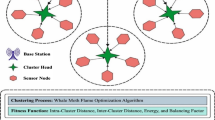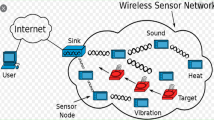Abstract
Wireless Sensor Network (WSN) is one of the most significant technologies that typically involves of a large number of wireless sensor nodes with sensing, communications and computation capabilities. The sustained operation of WSN is achieved through the efficient consumption of node energy. The WSN is used to many applications especially military, science and medical. The WSN performance may be affect some issues such as load balancing, security and reduce energy consumption of the nodes. These issues must be reduced to enhance performance of the WSN structure in different applications. Henceforth, in this paper, Hybrid Emperor Penguin Optimization (EPO) is developed to solve load balancing, security enhancement and reduce energy consumption in WSN. The hybrid EPO is combined with Atom Search Optimization (ASO) algorithm, it is used to improve the updating function of the EPO algorithm. Three major objective functions can be considered towards improve the performance of WSN like load balancing, security enhancement in addition energy consumption reduction. The load balancing can be achieved by optimal clustering scheme which attained applying proposed hybrid EPO. The security also enhanced in WSN with the help of hybrid EPO by computing security measures. Similarly, energy consumption of WSN is achieved optimal routing scheme by hybrid EPO algorithm. The proposed methodology is developed to manage three objectives which is a major advantage. The projected technique can be implemented by NS2 simulator for validation process. The projected technology is contrasted with the conventional methods such as EPO and ASO respectively. The projected technique is evaluated in terms of delivery ratio, network lifetime, overhead, energy consumption, throughput, drop and delay.











Similar content being viewed by others
Abbreviations
- \({Ener}^{T}\left(1,D\right)\) :
-
Energy model
- \({\epsilon }^{MP}\) :
-
Energy required for the amplifier
- \({E}^{Elec}\) :
-
Energy required for the electronic circuit
- d:
-
Distance
- \({Ener}^{R}\left(L\right)\) :
-
Energy requirement of receiver
- \({G}^{I}\) :
-
Distance of the gateway
- \(NEXT \left({G}^{I}\right)\) :
-
Nest gateway distance
- \(L\) :
-
Total number of gateways
- \(K\) :
-
Proportionality constant
- \({(W}^{1},{W}^{2})\) :
-
Weight parameter
References
Ding, Y., & Xiao, L. (2010). SADV: Static-node-assisted adaptive data dissemination in vehicular networks. IEEE Transactions on Vehicular Technology., 59(5), 2445–2455.
Yarinezhad, R., & Sarabi, A. (2019). A new routing algorithm for vehicular ad-hoc networks based on glowworm swarm optimization algorithm. Journal of AI and Data Mining., 7(1), 69–76.
Oubbati, O. S., Lakas, A., Lagraa, N., & Yagoubi, M. B. (2016). UVAR: An intersection UAV-assisted VANET routing protocol. IEEE Wireless Communications and Networking Conference, WCNC, 2016, 2016.
Wu, C., Yoshinaga, T., Ji, Y., Murase, T., & Zhang, Y. (2017). A reinforcement learning-based data storage scheme for vehicular ad hoc networks. IEEE Transactions on Vehicular Technology., 66(7), 6336–6348.
Baiocchi, A., Salvo, P., Cuomo, F., & Rubin, I. (2016). Understanding spurious message forwarding in VANET beaconless dissemination protocols: An analytical approach. IEEE Transactions on Vehicular Technology., 65(4), 2243–2258.
Wang, W., & Luo, T. (2016). The minimum delay relay optimization based on nakagami distribution for safety message broadcasting in urban VANET. In: IEEE Wireless Communications and Networking Conference
Zhang, W., Zheng, R., Zhang, M., Zhu, J., & Wu, Q. (2019). ECRA: An encounter-aware and clustering-based routing algorithm for information-centric VANETs. Mobile Networks and Applications., 25(8), 1–11.
Ravi, B., Thangaraj, J., & Petale, S. (2018). Stochastic network optimization of data dissemination for multi-hop routing in VANETs. In: Proceedings of the 2018 international conference on wireless communications, signal processing and networking, WiSPNET 2018
Wu, C., Ohzahata, S., & Kato, T. (2019). VANET broadcast protocol based on fuzzy logic and lightweight retransmission mechanism. IEICE Transactions on Communications. 95(2):415–425.
Leu, J.-S., Chiang, T.-H., Yu, M.-C., & Su, K.-W. (2015). Energy efficient clustering scheme for prolonging the lifetime of wireless sensor network with isolated nodes. IEEE Communications Letters., 19(2), 259–262.
Rajesh, M., & Manikanthan, J. M. (2017). Get-up-and-go efficientmemetic algorithm based amalgam routing protocol. International Journal of Pure and Applied Mathematics., 116(21), 537–546.
Zhang, W., Li, L., Han, G., & Zhang, L. (2017). E2HRC: An energy-efficient heterogeneous ring clustering routing protocol for wireless sensor networks. IEEE Access., 5, 1702–1713.
Zaman, N., Jang Low, T., & Alghamdi, T. (2014). Energy efficient routing protocol for wireless sensor network. In: Proceedings of the 16th IEEE international conference on advanced communication technology, pp 808–814.
Patel, A. B., & Shah, H. B. (2015). Reinforcement learning framework for energy efficient wireless sensor networks. International Research Journal of Engineering and Technology (IRJET)., 2(2), 1034–1040.
Zaman, N., Jung, L. T., & Yasin, M. M. (2016). Enhancing energy efficiency of wireless sensor network through the design of energy efficient routing protocol. Journal of Sensors., 1, 1–16.
Alghamdi, T. A. (2020). Energy efficient protocol in wireless sensor network: Optimized cluster head selection model. Telecommunication Systems., 74, 331–345.
Zeng, F., Zhang, R., Cheng, X., & Yang, L. (2017). Channel prediction based scheduling for data dissemination in VANETs. IEEE Communications Letters., 21(6), 1409–1412.
Yan, T., Zhang, W., & Wang, G. (2014). DOVE: Data dissemination to a desired number of receivers in VANET. IEEE Transactions on Vehicular Technology., 63(4), 1903–1916.
Khan, A. A., Abolhasan, M., & Ni, W. (2018). An evolutionary game theoretic approach for stable and optimized clustering in VANETs. IEEE Transactions on Vehicular Technology., 67(5), 4501–4513.
He, J., Ni, Y., Cai, L., Pan, J., & Chen, C. (2018). Optimal dropbox deployment algorithm for data dissemination in vehicular networks. IEEE Transactions on Mobile Computing., 17(3), 632–645.
Bali, R. S., & Kumar, N. (2016). Secure clustering for efficient data dissemination in vehicular cyber–physical systems. Future Generation Computer Systems., 56, 476–492.
Ullah, A., Yaqoob, S., Imran, M., & Ning, H. (2019). Emergency message dissemination schemes based on congestion avoidance in VANET and vehicular FoG computing. Special section on advanced big data analysis for vehicular social networks. IEEE Access, 7, 1570–1585.
Chahal, M., & Harit, S. (2019). Optimal path for data dissemination in vehicular ad hoc networks using meta-heuristic. Computers and Electrical Engineering, 76, 40–55.
Dhiman, G., Oliva, D., Kaur, A., Kant Singh, K., Vimal, S., Sharma, A., & Cengizh, K. (2021). BEPO: A novel binary emperor penguin optimizer for automatic feature selection. Knowledge-Based Systems, 211:106560.
Li, Z., & Junlei Bi, Y. S. (2019). CADD: connectivity-aware data dissemination using node forwarding capability estimation in partially connected VANETs. Wireless Networks. 25(1):379–398.
Zhao, W., Wang, L., & Zhang, Z. (2019). Atom search optimization and its application to solve a hydrogeologic parameter estimation problem. Knowledge-Based Systems., 163(1), 283–304.
Zhao, W., Wang, L., & Zhang, Z. (2019). A novel atom search optimization for dispersion coefficient estimation in groundwater. Future Generation Computer Systems., 2019, 601–610.
Author information
Authors and Affiliations
Corresponding author
Additional information
Publisher's Note
Springer Nature remains neutral with regard to jurisdictional claims in published maps and institutional affiliations.
Rights and permissions
About this article
Cite this article
Angel, M.A., Jaya, T. An Enhanced Emperor Penguin Optimization Algorithm for Secure Energy Efficient Load Balancing in Wireless Sensor Networks. Wireless Pers Commun 125, 2101–2127 (2022). https://doi.org/10.1007/s11277-022-09647-5
Accepted:
Published:
Issue Date:
DOI: https://doi.org/10.1007/s11277-022-09647-5




